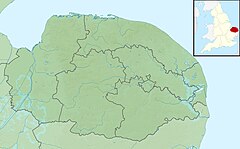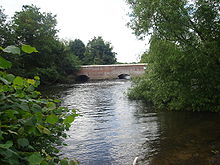
The Marriott's Way is a footpath, cycle-path and bridleway in north Norfolk, England, between Norwich and Aylsham via Themelthorpe. It forms part of the National Cycle Network (NCN) and the red route of Norwich's Pedalways cycle path network. It is open to walkers, cyclists and horse riders. Its total length is 24.6 miles (39.5 km). It has a mixture of surfaces: tarmac, compacted gravel and earth. The name of the route originates from the chief engineer and manager of the Midland and Great Northern Joint Railway (M&GNJR), William Marriott, who held the position for 41 years.

Fakenham is a market town and civil parish in Norfolk, England. It is situated on the River Wensum, about 25 miles north-west of Norwich. The town is at the junction of several local roads, including the A148 from King's Lynn to Cromer, the A1067 to Norwich and the A1065 to Swaffham.

The Mid-Norfolk Railway (MNR) is a 17+1⁄2 miles (28.2 km) preserved standard gauge heritage railway, one of the longest in Great Britain. Preservation efforts began in 1974, but the line re-opened to passengers only in the mid-1990s as part of the "new generation" of heritage railways. The MNR owns and operates most of the former Wymondham-Fakenham branch line of the Norfolk Railway. The branch opened in 1847, was closed to passengers in stages from 1964 to 1969 as part of the Beeching cuts, and was finally fully closed to goods traffic in 1989.

Taverham is a village and civil parish in Norfolk, in England. It is approximately 5 miles (8 km) north-west of Norwich. Taverham sits on the River Wensum. Taverham forms part the wider Norwich Built-up area.

Costessey is a town and civil parish in the South Norfolk district of Norfolk, England, and is 4 miles (6.4 km) north west of Norwich. The civil parish forms part of the Norwich Urban Area.
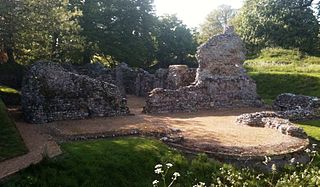
North Elmham is a village and civil parish in the English county of Norfolk. It covers an area of 7.41 sq mi (19.2 km2) and is located about 5 mi (8.0 km) north of East Dereham, on the west bank of the River Wensum. Including Gateley, the civil parish had a population of 1,428 in 624 households at the 2001 census; this increased slightly to 1,433 at the 2011 census.
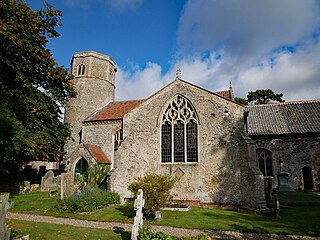
Great Ryburgh is a village and former civil parish, now in the parish of Ryburgh, in the North Norfolk district, in the county of Norfolk, England. In 1961 the parish had a population of 484. On 1 April 1987 the parish was abolished and merged with Little Ryburgh to form "Ryburgh".
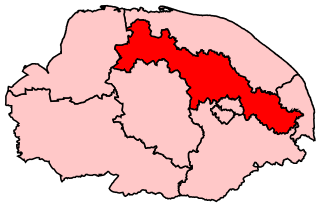
Broadland is a Norfolk constituency, which has been represented in the House of Commons of the UK Parliament since the 2019 general election by Jerome Mayhew, a Conservative.
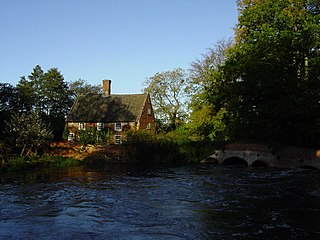
Lyng is a village and civil parish in the English county of Norfolk. It is situated on the River Wensum, some 10 km (6.2 mi) north-east of the town of East Dereham and 20 km (12 mi) north-west of the city of Norwich.
The following are lists of recreational walks in Norfolk, England.
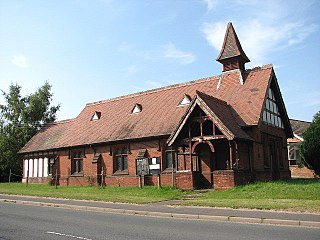
Lenwade is a village in the civil parish of Great Witchingham, Norfolk, situated in the Wensum Valley adjacent to the A1067 road 14 miles (23 km) south-east of Fakenham and some 11 miles (18 km) north-west of Norwich. The River Ainse joins the Wensum at Lenwade. In 2001 it had a population of 464.

Ryburgh is a civil parish in the English county of Norfolk. The parish is 21.2 miles (34.1 km) south-west of Cromer, 23.1 miles (37.2 km) north-west of Norwich and 117 miles (188 km) north-east of London. The parish lies 4 miles (6.4 km) south-east of the nearby town of Fakenham. The nearest railway station is at Sheringham for the Bittern Line which runs between Sheringham, Cromer and Norwich. The nearest airport is Norwich International Airport. The parish includes the villages of Great Ryburgh and Little Ryburgh.

Felthorpe is a village and civil parish in the English county of Norfolk. The village is located 11 miles (18 km) east of Dereham and 7.1 miles (11.4 km) north-west of Norwich.

Drayton, Norfolk, is a suburban village in the English county of Norfolk. The village is located in the district of Broadland, 4.3 miles (6.9 km) north west of Norwich, on the A1067 road between Hellesdon and Taverham. Today, Drayton is largely dominated by the Thorpe Marriott housing estate built in the late Twentieth Century.

The River Wensum SSSI is a 'whole river' Site of Special Scientific Interest located on the River Wensum that flows through the English county of Norfolk. The river was designated a SSSI in 1993 and a Special Area of Conservation SAC in 2000. It covers 44 miles (71 km) of the Upper Wensum from its source close to South Raynham downstream to Hellesdon Mill an area of 971.9 acres (393.3 ha).

Hellesdon High School is a secondary school and, on site, is a sixth form with academy status in Hellesdon, Norfolk, England. The school is part of the Wensum Trust.

Network Norwich is the brand name given to First Norfolk & Suffolk bus services in and around the city of Norwich. First launched in September 2012, the network now consists of nine colour-coded lines extending across Norwich city centre, outer suburbs, and surrounding towns and villages across Norfolk and into Suffolk.

